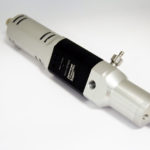Many everyday products – consciously, but often unconsciously – contain silicone. These include smartphones, automotive components, household appliances, textiles, toiletries and medical products – to name just a few. Due to the unique material properties of silicone parts, it is possible to produce it in a wide range of varieties, such as for example, heat-resistant, water-repellent, elastic and UV-resistant, resistant to environmental influences and cold-resistant.
The market for a wide variety of silicone applications has developed steadily over the last few years, however, it was not until the past few years that a more innovative technology could be presented in addition to proven production techniques such as silicone injection molding: The three-dimensional printing of silicone. A special challenge is the handling, as well as the processing systems, for the sophisticated production of silicone components.
Precise printing of the finest silicone layers with a ViscoTec print head
ViscoTec has been dealing with the 3D printing of silicones for a long time. In November 2017, the single component print head was presented at the formnext exhibition in Frankfurt. The dosing technology specialist has therefore responded specifically to the demand for viscous fluids and pastes in 3D printing. Layer by layer, the print head applies a constant line of silicone in fine layers of up to 200 microns.
This method follows the volumetric dosing principle based on the progressive cavity pump technology. The perfect interaction of the rotor and stator results in closed chambers with identical volumes, which ensures a precise application of silicone during 3D printing. In addition, it is technically possible to produce a specific thread breakage at the end of the line by creating a suck-back. The cross-linking of the individual silicone layers takes place independently of the printing technology and can occur depending on the choice of materials between UV, heat and moisture or a combination of them. An individual and customer-specific solution is therefore possible.
In addition to its application in the printing process, the progressive cavity technology is used also in material withdrawal and processing systems. In additive manufacturing, larger containers, such as pail systems filled with silicone, can be fed directly to the print head. This ensures a uniform and high-quality processing of silicones throughout the entire process, from material withdrawal to printing.
New areas of application and new markets thanks to the 3D printing of silicone parts
A tangible working example is the 3D printing of silicone seals for a wide range of applications. Currently, gaskets are manufactured in very high volumes using a conventional injection molding process. However, particularly during the development phase of new seals, high costs are incurred to make the first prototypes, as a costly tool has to be produced. 3D printing, on the other hand, makes it possible to skip the production of a tool and to create a 3D printed prototype. An existing series of experiments show that the components produced by additive manufacturing have almost the same mechanical properties as the injection molded component.
Depending on the silicone to be used, it is possible to work with one and the same product material from the development phase through to the final production phase of a component. By eliminating the tooling, not only are the development costs reduced, but also the production time between the development and the finished seal. Another challenge now is to move from prototypes to the small-scale production of complex components and to ensure process reliability of the manufactured components.
The post 3d printing of silicone parts in additive manufacturing appeared first on ViscoTec Pumpen- u. Dosiertechnik GmbH.



